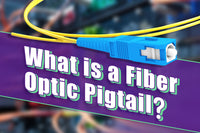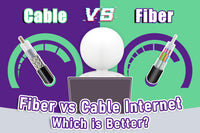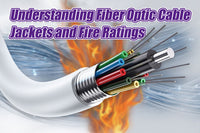Fiber optic networks represent standards for high-speed and high-bandwidth data transmission. However, achieving optimal performance requires not only correct fiber optic installation but also diligent maintenance. Because of the fragile nature of optical fibers, it’s crucial for technicians or homeowners to know how to correctly clean fiber optics. Unfortunately, many people are unaware of the proper cleaning techniques. Don’t worry, we’ll further explore essential tips and methods for effectively cleaning fiber optic.
To Clean or Not to Clean?
Some of our users wonder if they need to clean fiber optic components regularly. In fact, it is important to note that too frequent cleaning is not necessary and may even contaminate the fiber optic system and affect your network performance.
Cleaning fiber optics before fiber optics installation is often more crucial than regular maintenance. A new cable may not remain clean after undergoing manufacturing, packaging, and shipping processes. In addition, dust, oil, skin oil, water residue, and other microscopic particles can also cause contaminants during installation, potentially causing network errors that disrupt data transmission. Therefore, ensuring that fiber optics are thoroughly cleaned is crucial to prevent network issues and ensure long-term reliability.
Fiber Optic Cleaning Methods
There are three common methods for fiber optic cleaning: wet cleaning, dry cleaning, and combination cleaning. Each of them is designed to remove dust and other contaminants from the fiber connectors and end faces, ensuring fiber optic reliability.
Wet Cleaning
Wet fiber cleaning involves using reagent-grade 99% isopropyl alcohol (IPA), or a specialized wetting solvent formulated for fiber optics. Wet cleaning is a good choice for removing oils, greases, and other residues.
When using IPA, you should be careful to avoid contaminating the end face. On the one hand, IPA is not suitable for cleaning all types of contaminants. On the other hand, high-purity IPA can absorb water in the air and further contaminate the end faces. So it is recommended that you use an individually packed lint-free wipe to minimize the risk of contamination.
Wet cleaning with a wetting solvent can be more effective in removing stubborn contaminants, but it requires correct handling and proper solvent to avoid damaging the fiber ferrule.
Dry Cleaning
Dry cleaning refers to cleaning fiber optics with a dry tool like a lint-free wipe, swab, and fiber cleaners such as click type cleaner, cassette cleaner, etc. Dry cleaning is suitable for cleaning light contamination, but it is more difficult than wet cleaning to eliminate stubborn contaminants completely. The dry fiber optic cleaning can cause static charge and may attract other additional contaminants.
Combination Cleaning
Wet-to-dry cleaning uses wipes, swabs, and fiber cleaning tools. Apply a proper amount of solvent on the lint-free cloth, and then clean the fiber optic straight from the wet part to the dry area on the cloth. Wet-to-dry cleaning solves the problem of static charge and avoids contamination while wiping the fiber end.
Common Fiber Cleaning Tools
There are many cleaning tools for fiber optic cleaning like click pen, reel-type cleaner, lint-free swabs, lens paper, compressed air, isopropyl alcohol, etc. The following are the commonly used tools:
- FiberOptic Cleaning Alcohol or Specialized Solvent: It is effective in cleaning the usual contaminants on the connectors and fiber cables. But it should be noted to follow the guidelines for using these chemical liquids for safety.
- Click-type Cleaners: One-click fiber cleaner uses a mechanical push to easily clean fiber connectors. The “click” sound indicates the engagement with the end face of the fiber optic cable. This compact cleaning pen provides high-performance cleaning results even in tight places and hard-to-reach areas.
- Reel-type Cleaners: They are also known as cassette cleaners, which are portable cleaning tools that contain a replaceable cleaning tape or reel. It is a safe and simple way to eliminate contaminants from fiber connectors and end faces, making them ideal for field use.
- Compressed Air: Clean Dry Air (CDA) free of water, oil, and dust is used to blow away some contaminants like dust, and particles.
- Lint-free Wipes: Lint-free wipes are used in dry, wet, or wet-to-dry cleaning methods. It is recommended to use packaged wipes to avoid contamination.
Inspection tools like fiberscopes and bulkhead probes also play a crucial role in the cleaning process. The fiberscope requires a specific adapter to inspect various connectors with 1.25mm or 2.5mm ferrules. The bulkhead probe functions similarly to a handheld fiberscope, simplifying the inspection process.
How to Clean Fiber Connector?
How to clean fiber optic components? We’ll delve into a comprehensive tutorial covering fiber connectors.
Step 1: Turn off the laser before cleaning and never look directly at the fiber when it is energized as it can damage your eyes.
Step 2: Take off the protective cap on the connector and inspect the connector with a microscope or bulkhead probe to identify any debris.
Step 3: Gather necessary cleaning tools like lint-free wipes, swabs, click-type cleaners, or solvents in your optical fiber cleaning kit.

Step 4: Determine the cleaning method. Wet-to-dry cleaning is recommended for cleaning both stubborn and light contamination. Put a drop of solvent on the wipe, then move the connector from the wet part to the dry area straightly.

Step 5: Inspect the cleaned end face. If the connector is free of contaminants, put the cap securely.

If you are familiar with the process of fiber optic connector cleaning, cable cleaning and transceiver cleaning won’t be difficult for you.
Tips for Fiber Optic Cleaning
- Keep the power off until the cleaning is finished.
- Keep the cap of the connector in a sealed container during the clean
- Don’t let your finger touch the cleaned area of the connector.
- Don’t touch the alcohol-soaked part of the wipe, swab, or other tools.
- Don’t reuse cleaning tools like wipes, swabs, or reel cleaners.
- Never touch the end face of the connector with your hands.
- Don’t look directly when the laser turning on.
- Always inspect your fiber optic components before and after cleaning.
Conclusion
Cleaning fiber optics is important to ensure the integrity and reliability of the fiber optic network. By using appropriate cleaning tools and recommended cleaning procedures, you can effectively remove the contaminants from fiber optic components.
FAQs
Can dust affect fiber internet speed?
Dirt or dust cumulation can obstruct the transmission of light from the fiber optic core to the connector, potentially degrading the fiber internet speed.
Does inspection matter in fiber optic cleaning?
Always remember inspection plays an important role before or after fiber optic cleaning.
Can I place solvent as much as I want on the wipe to clean fiber optic connectors?
No, too much solvent may ultimately result in contaminants.
For more information on this topic, you can keep up on our blogs. While VCELINK offers general and basic information for our customers and other visitors to the website, it’s not professional advice.



What about the cleaning of female socket of toslink